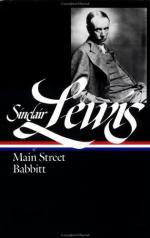The Jolly Seventeen laughed, and Carol laughed with them. Mrs. Jack Elder added that this Erik Valborg had confided to Mrs. Gurrey that he would “love to design clothes for women.” Imagine! Mrs. Harvey Dillon had had a glimpse of him, but honestly, she’d thought he was awfully handsome. This was instantly controverted by Mrs. B. J. Gougerling, wife of the banker. Mrs. Gougerling had had, she reported, a good look at this Valborg fellow. She and B. J. had been motoring, and passed “Elizabeth” out by McGruder’s Bridge. He was wearing the awfullest clothes, with the waist pinched in like a girl’s. He was sitting on a rock doing nothing, but when he heard the Gougerling car coming he snatched a book out of his pocket, and as they went by he pretended to be reading it, to show off. And he wasn’t really good-looking—just kind of soft, as B. J. had pointed out.
When the husbands came they joined in the expose. “My name is Elizabeth. I’m the celebrated musical tailor. The skirts fall for me by the thou. Do I get some more veal loaf?” merrily shrieked Dave Dyer. He had some admirable stories about the tricks the town youngsters had played on Valborg. They had dropped a decaying perch into his pocket. They had pinned on his back a sign, “I’m the prize boob, kick me.”
Glad of any laughter, Carol joined the frolic, and surprised them by crying, “Dave, I do think you’re the dearest thing since you got your hair cut!” That was an excellent sally. Everybody applauded. Kennicott looked proud.
She decided that sometime she really must go out of her way to pass Hicks’s shop and see this freak.
II
She was at Sunday morning service at the Baptist Church, in a solemn row with her husband, Hugh, Uncle Whittier, Aunt Bessie.
Despite Aunt Bessie’s nagging the Kennicotts rarely attended church. The doctor asserted, “Sure, religion is a fine influence—got to have it to keep the lower classes in order—fact, it’s the only thing that appeals to a lot of those fellows and makes ’em respect the rights of property. And I guess this theology is O.K.; lot of wise old coots figured it all out, and they knew more about it than we do.” He believed in the Christian religion, and never thought about it, he believed in the church, and seldom went near it; he was shocked by Carol’s lack of faith, and wasn’t quite sure what was the nature of the faith that she lacked.
Carol herself was an uneasy and dodging agnostic.
When she ventured to Sunday School and heard the teachers droning that the genealogy of Shamsherai was a valuable ethical problem for children to think about; when she experimented with Wednesday prayer-meeting and listened to store-keeping elders giving their unvarying weekly testimony in primitive erotic symbols and such gory Chaldean phrases as “washed in the blood of the lamb” and “a vengeful God”; when Mrs. Bogart boasted that through his boyhood




